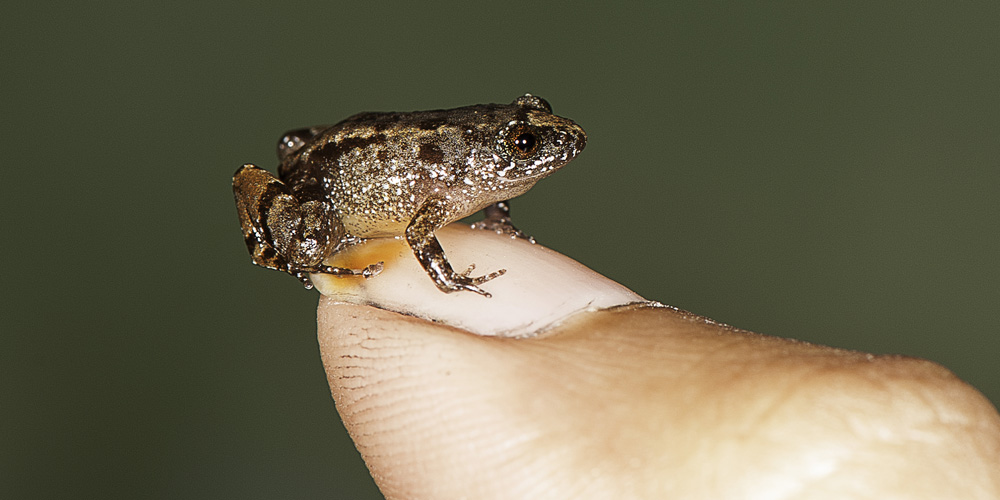Frogs Fit on a Fingertip: Tiny New Species Discovered in India

Some of the smallest known frogs were recently discovered following a five-year survey in India. Seven new species of "night frogs," in the Nyctibatrachus genus, include four species that are among the tiniest frogs ever found, capable of comfortably crouching on a thumbnail with room to spare.
Though the frogs were abundant in the survey area, their minuscule size and chirping calls — which resemble the sounds of insects — enabled them to remain undetected until now, scientists wrote in a new study.
Their discovery raises the total number of known night frog species to 35, with seven species recognized as miniaturized — smaller than 0.7 inches (18 millimeters). [So Tiny! Miniature Frog Species Are Among World's Smallest (Photos)]
The smallest of the newly described frogs — Nyctibatrachus manalari, N. pulivijayani, N. robinmoorei and N. sabarimalai — measure between 0.5 and 0.6 inches (12.2 and 15.4 mm).
N. webilla and N. athirappillyensis are slightly larger than their cousins at approximately 0.7 inches and 0.8 inches (20 mm) respectively, while the largest of the new finds, N. radcliffei, measured 1.5 inches (38.3 mm).
![Seven new species discovered from the Western Ghats. A. Radcliffe’s night frog (Nyctibatrachus radcliffei), B. Athirappilly night frog (Nyctibatrachus athirappillyensis), C. Kadalar night frog (Nyctibatrachus webilla), D. Sabarimala night frog (Nyctibatrachus sabarimalaiI), E. Vijayan’s night frog (Nyctibatrachus pulivijayani), F. Manalar night frog (Nyctibatrachus manalari), G. Robin Moore’s night frog (Nyctibatrachus robinmoorei). [(D-G. Size of the miniature species in comparison to the Indian 5-rupee coin (24 mm diameter)].](https://cdn.mos.cms.futurecdn.net/oY6w2vz26TGzKjywxHPrX7.jpg)
Night frogs are native to the Western Ghats mountain range, one of the world's richest biodiversity hotspots and a United Nations Educational, Scientific and Cultural Organization (UNESCO) World Heritage Site. The region runs parallel to India's western coast, covering an area measuring approximately 54,054 square miles (140,000 square kilometers).
It is home to hundreds of species of animals and plants that are recognized as globally threatened, with 145 species listed as endangered and 51 as critically endangered, UNESCO reported in a site description.
Get the world’s most fascinating discoveries delivered straight to your inbox.
Over the past decade, scientists have described 103 new species from the Western Ghats, including the unusual Indian purple frog, which is found nowhere else on Earth and is the only living frog in an evolutionary lineage dating back to the Jurassic.
What the future holds for night frogs — and for many of their fellow amphibians — is uncertain, as more than 32 percent of the Western Ghats frogs are threatened with extinction, according to the study co-author, SD Biju, a biologist and head of the Systematics Lab with the Department of Environmental Studies at the University of Delhi, India.
"Out of the seven new species, five are facing considerable anthropogenic threats and require immediate conservation prioritization," Biju said.
The new findings emphasize that biodiversity in the Western Ghats is dramatically underestimated — even in well-studied groups like night frogs — and highlight the urgency of implementing conservation measures to protect threatened wildlife, and to preserve the habitats of as-yet undiscovered species, the study authors wrote.
The findings were published online today (Feb. 21) in the open access journal PeerJ.
Original article on Live Science.

Mindy Weisberger is a science journalist and author of "Rise of the Zombie Bugs: The Surprising Science of Parasitic Mind-Control" (Hopkins Press). She formerly edited for Scholastic and was a channel editor and senior writer for Live Science. She has reported on general science, covering climate change, paleontology, biology and space. Mindy studied film at Columbia University; prior to LS, she produced, wrote and directed media for the American Museum of Natural History in NYC. Her videos about dinosaurs, astrophysics, biodiversity and evolution appear in museums and science centers worldwide, earning awards such as the CINE Golden Eagle and the Communicator Award of Excellence. Her writing has also appeared in Scientific American, The Washington Post, How It Works Magazine and CNN.
